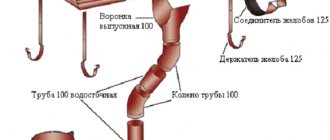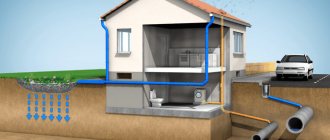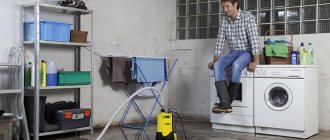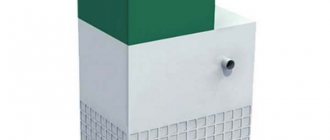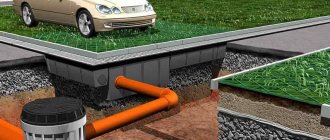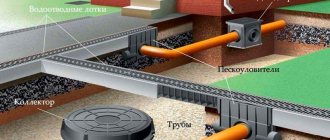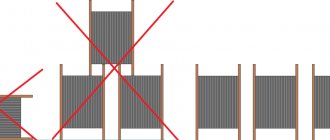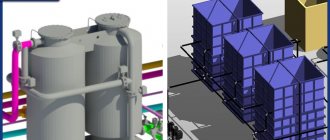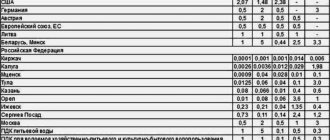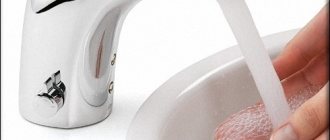Storm (rain) sewerage is a type of drainage system that promptly removes wastewater from the serviced area. Depending on the conditions of use, such systems may have a different set of functional components, different dimensional parameters and protective additions. As for the areas of application, the storm sewer system is used in the arrangement of city streets, in the infrastructure of industrial facilities and in the engineering and communication support of private households.
Sewer structure
Like any other plumbing infrastructure, storm drains operate on the basis of pipeline networks. With the help of pipes, water moves from one functional point of the system to another. The working cycle begins from areas with storm water inlets, which carry out local water collection. Trays with gutters often serve in this capacity. They are installed in drainage ditches so that the wastewater can flow by gravity to the distribution collector. A type of rainwater inlet is also a door pan. Such devices are installed either at the gate or near the entrance to the house.
The installation of storm sewer systems requires the presence of capacitive water storage tanks. These are devices that accumulate water collected in primary water intakes. They can be implemented in different ways, but the main task remains the same - to ensure sufficient intake of surface water to eliminate the risk of flooding in the area.
Cleaning function of the storm sewer system
Unlike a septic tank, which receives household waste and sewage, rainwater drainage does not require deep biological treatment. Of course, there are systems in which the septic tank also acts as a receiver for storm water. And in this case, cleaning will completely depend on the capabilities of this tank. A septic tank can act as a simple storage tank without cleaning functions, or as a means of multi-stage filtration. Separating the tasks of a septic tank and storm sewer is just advisable due to different cleaning requirements. Rainwater can easily be discharged into the ground without the risk of disturbing the ecological state of the soil. However, basic filtration is still required to protect the drainage system itself. Therefore, a storm drain cleaning system often includes sand traps that trap large soil particles, debris and stones. That is, mechanical cleaning filters are used that prevent physical contamination of the pipeline, storage tank and collector units.
Classification by drainage method
At the moment, there are three types of sewer systems designed for rainwater. First of all, this is a ditch configuration with open drainage channels. Such systems are usually used in cities and can perform several tasks, including draining wastewater and irrigating gardening areas. Structurally, such networks are formed by systems of concrete ditch trays placed along roads and streets. Ditch trays are distinguished by a perforated surface, which allows water to be passively distributed over the soil cover. Also, an external storm drainage system can be used in the arrangement of private households with plots, but this solution will be ineffective. In urban conditions, an open system is advantageous due to its high productivity, as it works with large volumes of water. But in a small area, the closed system option is more effective. In this configuration, water runoff is collected in trays that are part of the landscape structure. In other words, the pipeline network is placed in a ground niche and covered with protective devices. The third option is a combined design in which open and closed sections replace each other depending on the conditions of the drainage circuit.
Autonomous sewer system
Used when it is not possible to connect to a centralized sewer system. It removes and purifies wastewater from a specific facility, its throughput is calculated in accordance with the average volumes of water consumption. They can be arranged in several ways. The most commonly used solutions are:
- storage capacity. Discharged wastewater accumulates inside a tank, which is pumped out at certain intervals as the tank fills;
- septic tank A group of tanks in which wastewater settles for a certain time. After solids and impurities settle in the first tank, the wastewater moves to the next tank, where more thorough treatment occurs. Typically the number of such tanks is from 2 to 4. The more tanks are used, the better the quality of wastewater treatment. Treated wastewater is discharged to filtration fields or to a spillway point. Such sewer systems involve only mechanical wastewater treatment;
- VOC. Local treatment facilities. It is assumed that wastewater is purified as a result of the decomposition of impurities by anaerobic and aerobic bacteria. The process of decomposition of impurities occurs under different conditions depending on their composition. All equipment is supplied in a single case. As a result of cleaning, up to 98% of impurities are destroyed. Treated wastewater is discharged to the nearest spillway point (ravine, ditch, etc.).
Such systems are used in the construction of country houses and cottages, as well as small commercial buildings, the wastewater of which is domestic. For industrial, agricultural and other similar facilities, more complex solutions and specialized equipment for wastewater treatment are used.
Sewage systems can have different purposes:
- household and fecal. Used for cleaning and draining wastewater from kitchen sinks, bathrooms, etc.;
- production. It is used in industrial and agricultural enterprises for the treatment of wastewater contaminated with toxic, potentially hazardous, etc. impurities;
- rain or storm. It is used to drain melt and rain water accumulating on the ground.
Centralized sewers often perform the functions of both domestic sewage and storm sewers. When arranging autonomous systems, engineers recommend dividing them according to purpose (separately installing stormwater and wastewater systems). This will avoid overloading in the event of heavy rainfall or rapid melting of large amounts of snow.
Classification by tank configuration
Both open and closed sewer systems differ in the way the catchments are organized. In point schemes, receiving funnels with gratings are installed separately from each other. That is, small underground or above-ground containers can be scattered throughout the site in accordance with the most intense water flow. In this case, all points of the water collectors are combined into a single network directed to the storage tank. An alternative method is a linear arrangement of collections. In this way, a continuous drainage and storm sewer system is formed on the site, which, already in the collection process, combines several sources of water supply. Otherwise, the equipment of rainwater collection and drainage channels is carried out according to general principles with the integration of filters, collector units and gratings.
What is a storm drain?
This is a utility network whose purpose is to collect excess moisture from a certain area and then drain it away. Requirements for the construction of storm sewers (storm drains) are established by SNiP 2.04.03-85.
It is this document that must be followed at all stages: during preliminary calculations, design and construction itself. It is important to note that SNiP 2.04.03 - this is the spelling that is sometimes found - does not actually exist, this is an incorrect spelling of the norms, the number of which is indicated above.
Sometimes the question arises about the need to comply with SNiP: can’t sewerage in small areas be built without complex calculations and design, “by eye”?
No, because failure to comply with certain rules often results in disruption of the entire system, problems due to stagnation of water, as well as losses. Hence the conclusion: if a site really needs storm sewerage, SNiP is a mandatory document.
Rainwater drainage design
Even storm drains for small areas must be arranged on the basis of a design solution in which pumping lines, points of collection, distribution and accumulation of water are calculated. Moreover, the basis for the project can be developed independently, by identifying the most likely sources of water spills and the optimal location for its reception. The plan will have to include the contours of drains, the location of communications, equipment and storage tanks. More serious drainage system and storm sewer projects also include geodetic surveys of the area. One of the main objects of analysis will be the level of groundwater, which will allow us to determine the optimal location for the drainage system and storage tank, which ensures the discharge of wastewater directly into the ground.
Installation of pipeline and related equipment
It is advisable to use plastic pipes, as they do not corrode, are easy to install and require virtually no maintenance. Laying is carried out in a trench, the bottom of which is first filled with sand, crushed stone and covered with geotextiles. Next, the formed network must be wrapped in geotextile so that the drainage filler completely covers the surface of the pipes. Connections are made using complete couplings of the appropriate standard size. Then the functional units of collectors, a collector and a receiver are installed, with which the storm sewer system will interact. Installation must be carried out in compliance with the slope towards the place where water accumulates. So, per 1 m, about 1-2 cm of inclination should be provided. The same applies to networks in which the final collection point is the main sewer network. It is not worth filling the channels until the pipeline has been tested under operating conditions.
How to calculate the efficiency of a storm drain
It will be easy for any owner of suburban real estate to make calculations based on the following indicators
Pipe laying depth
There are no clear norms and rules on the level of immersion of pipes in SNiP; in general, recommendations are prescribed. It is advisable to lay below the soil freezing level; if this is not possible, then it is imperative to strengthen the waterproofing and insulate the pipeline.
Products with a cross-section of up to 50 mm are laid 30 cm below the freezing level; with a cross-section of more than 50 mm, the immersion of pipes reaches 50 cm from the freezing level.
Each option requires a depth of at least 70 cm (from soil level to pipe).
At what angle should trays and pipes be installed?
For high-quality operation of storm drainage systems, it is necessary to maintain the slope angle of the pipes. If the slope is small, the gravity flow may be weak, and the wastewater will not have time to drain; too large an angle will increase the flow speed, which will also negatively affect the storm drainage system.
The slope angle of the pipeline is calculated according to the SNiP table. For a private home, you can use a simplified option:
- For products with a cross-section of 110 mm - a slope of 2 cm per linear meter.
- 150 mm section requires 8-10 cm of slope
- Diameter 200 mm - 7 cm per linear meter
- 500 mm – slope 3 cm per meter of product.
Along the entire length of the pipeline, one slope is maintained, with one exception; in front of the sand trap, the slope angle is minimized to reduce the flow speed.
Average volume of liquid to be drained
The performance of a storm sewer system is calculated using the formula
Q = q20 × F × Ψ
–volume of liquid to be drained
Q- q 20 - coefficient of average precipitation
- F – area of the site
- Ψ – correction factor (how the type of soil absorbs moisture).
- Ψ = 1.0 for roofing – no absorption
- Ψ = 0.95 for asphalt
- Ψ = 0.85 for concrete pavements
- Ψ = 0.4 for crushed stone and gravel
- Ψ = 0.35 for open soil and lawn cover.
According to statistics, for the installation of storm sewers in the private sector, pipes with a cross-section of 100-110 mm are used; if the system has a collector, then the diameter of the products is 200 mm.
Important. When drawing up a storm drain scheme, you should pay attention that periodically it will require repair and cleaning, which is carried out using a portable Karcher or manually. If you use pipes with a diameter of more than 200 mm, it will be impossible to do the work yourself; you will need to call specialists with equipment.
Installation of sewer cover
The simplest way to cover a trench with a storm drainage channel is to backfill it with the same excavated soil. But to do this, you need to make sure that the line is reliably sealed, and that its structure contains layers of sand and crushed stone. If the channel passes through critical functional areas on the site, then additional reinforcement may be required. Additional reinforcement must be installed under paths, parking areas and vehicle entry areas. For this purpose, floors can be used, which are subsequently also covered with a dense layer of soil. But even at the stage of installing a storm sewer system, it is recommended to calculate the load on the network using the appropriate pipes. In particular, it is recommended to lay a non-perforated metal pipe under the road for a car. The use of plastic is also allowed, but in an armored shell. Layers of drainage and geotextiles are made according to the same scheme as on the other contours.
Organization of a security zone near the sewerage system
Hydrological resources that provide water supply are introduced into special protection zones in accordance with SNiP standards. The same rules apply to sewers. If we are talking about urban and public areas, then the radius of such areas should be about five meters. Of course, in a private household, strict compliance with this standard is not required, but it would still be useful to support some of the principles by which the storm sewer system and the adjacent area are protected. In particular, it is prohibited to build temporary structures, create garbage dumps, create flower beds and plant trees near canals.
Storm drain cleaning
Regardless of the type and location, rainwater drains must be flushed regularly. For this purpose, pumps are used that are installed at water collection sites. In a household, you can get by with one unit, moving it one by one to each circuit leading to the place of water accumulation. The pump is connected to the local water supply system and is directed by a pressure jet along the channel towards the slope. The flow eliminates contaminants in confined areas that are physically impossible to reach. Also, the rules for using the storm sewer system require separate cleaning of the storage tank. Moreover, internal surfaces must be regularly subjected to chemical disinfection in order to maintain the proper sanitary and environmental condition of the territory.
Operation and maintenance of storm drainage systems
The fastest and safest way to arrange a storm drain is to discharge water into a collective collector; the duration of work will increase significantly if you have to construct a drainage well, or divert water outside the site. Pipes for storm drainage can be made of plastic, metal or concrete, but the quality of work will depend not on the material of the pipes, but on the high-quality installation of joints and compliance with slopes. Preventive maintenance of storm drains should be carried out at least once every six months, special attention should be paid to cleaning the sand trap and filters from leaves, debris, etc. Standard maintenance of storm drains includes washing the trays, cleaning trash baskets and storm water inlets.
Features of drainage system care
The drainage system associated with the sewer discharge requires a special approach to maintenance. First of all, the upper layer of the drain should always be kept loose - this way it more effectively absorbs and passes water into the ground. For the same reason, it is not recommended to walk on embankments of sand and gravel, much less use heavy equipment on them. If the drainage and storm sewer system on the site is connected to intermediate wells and collector units, then they should be cleaned of dirt and sand in a separate order. It is advisable that this work be carried out automatically using pump washers with floats.
Journal "Ecology of Production", No. 3, 2021
January 01, 2021 marked 3 years since the entry into force of the Federal Law “On Water Supply and Wastewater Disposal”, which regulates relations for the disposal of wastewater through centralized sewerage systems (CSS). And at the same time, there is still no clear definition of what exactly a water supply system is, in which cases sewerage systems operated by organizations are not a water supply system, and the Federal Law “On Water Supply and Sewerage” does not apply to their legal relations with subscribers.
The assignment of a specific sewerage system to a central sewerage system automatically entails the need to be guided by all the requirements of the Federal Law “On Water Supply and Sanitation” [1] and the by-laws adopted in its implementation, which provide, among other things:
- the need, with the participation of local governments and bodies of constituent entities of the Russian Federation, to develop and approve a sewerage scheme, investment and production programs, and establish tariffs for wastewater services provided;
- the need to identify a guaranteeing organization;
- review of the content and procedure for concluding contracts for sewerage and sanitation services;
- special procedure for control over wastewater discharge, declaration of discharge by subscribers;
- limitation of discharges from subscribers by wastewater disposal standards for the volume and composition of wastewater, as well as requirements to prevent negative impacts on the operation of the central water supply system, and payment of subscribers for violation of these standards and requirements.
Many of these requirements in some cases can be burdensome both for organizations receiving wastewater and for their subscribers, in particular in situations when we are talking about receiving wastewater inside an industrial unit.
- The uncertainty begins with Article 2 of this Federal Law [1], which sets out the basic terms in the field of water supply and sanitation. According to paragraph 28 of this article, TsSV is a complex of technologically interconnected engineering structures, intended for drainage. At the same time, water disposal is the reception, transportation and treatment of wastewater using CSV (Clause 2 of Article 2 of the Federal Law “On Water Supply and Sanitation” [1]). In fact, these concepts are closed to each other and do not give an idea of what CSV is. If we look at the conceptual apparatus further, Article 2 of the Federal Law “On Water Supply and Sanitation” [1] states that:
- wastewater of the centralized water supply system - received from subscribers in the centralized water supply system , as well as rain, melt, infiltration, irrigation, and drainage water, if the centralized water supply system is intended to receive such water;
- subscriber – an individual or legal entity who has entered into or is required to enter into a water disposal agreement , a single agreement for cold water supply and sanitation.
- According to Part 11 of Article 7 of the Federal Law “On Water Supply and Sanitation” [1], the Government of the Russian Federation defines the types of water supply systems in the rules for cold water supply and sanitation. Clause 107 of the Rules for Cold Water Supply and Sanitation [2] states that, depending on their purpose, water supply systems are divided into the following types:
- centralized household wastewater systems designed for receiving, transporting and treating wastewater generated as a result of household activities of the population (hereinafter referred to as household wastewater);
- centralized storm drainage systems designed for receiving, transporting and treating surface wastewater;
- centralized general drainage systems designed for receiving, transporting and treating household wastewater and surface wastewater;
- centralized combined drainage systems designed for the reception, transportation and treatment of domestic wastewater and surface wastewater, consisting of domestic, storm and general drainage systems.
- Another criterion for classifying sewerage systems as a sewerage system is manifested in the systematic interpretation of the legislation on wastewater disposal. Thus, on the basis of clause 3, part 1, article 3 of the Federal Law “On Water Supply and Sanitation” [1], state policy in the field of water supply and sanitation is aimed at achieving, among other things, such a goal as reducing the negative impact on water bodies by improving the quality of wastewater treatment. Despite the fact that, according to the definition given in Article 2 of this Federal Law [1], wastewater disposal consists of the reception, transportation and treatment of wastewater, on the basis of Part 1 of Article 14 of the Federal Law “On Water Supply and Sanitation” [1] under a water disposal agreement The water and wastewater services organization also undertakes to discharge wastewater received from the subscriber at the water treatment center into the water body . According to clause 25 of the Rules for Cold Water Supply and Wastewater Disposal [2], the organization providing water disposal undertakes to receive the subscriber’s wastewater at the water disposal center and ensure its transportation, treatment and discharge into the water body . From the content of Article 27 of the Federal Law “On Water Supply and Wastewater Disposal” [1] it directly follows that VAT is established for subscribers specified in the Decree of the Government of the Russian Federation No. 230 [3] for discharge into water bodies through the water supply system. Until January 01, 2021, it is mandatory for everyone to comply with the wastewater disposal standards established on the basis of clause 61 of Rule No. 167 [4] for the composition of wastewater, based on such conditions as compliance with the norms of maximum permissible discharges of wastewater and pollutants into water bodies , approved for water and wastewater services organizations by environmental authorities. Also, water disposal standards for the volume of wastewater are established for subscribers, which, on the basis of subparagraph “b” of paragraph 136 of the Rules for cold water supply and sanitation [2], are determined taking into account the conditions established by the organization carrying out water disposal in the decision to provide a water body for use (in part of the wastewater discharge). Clause 2 of Requirements No. 782 [5] defines that the technological wastewater disposal zone is part of the sewer network belonging to the organization engaged in wastewater disposal, within which the reception, transportation, treatment and disposal of wastewater or direct (without treatment) release of wastewater into water body . Thus, the legislation on water disposal regulates those legal relations that are associated with the discharge of wastewater received from subscribers into water bodies . At the same time, there are situations when wastewater received from subscribers is not discharged into water bodies, but into specially created hydraulic structures - ponds (storage tanks, evaporators, etc.). Taking into account the above conclusion, such legal relations as those not related to the discharge of wastewater into water bodies should not be regulated in accordance with the Federal Law “On Water Supply and Sanitation.
- However, there is the following nuance. Based on Part 4, Clause 3, Part 5, Article 38 of the Federal Law “On Water Supply and Sanitation” [1], water supply and sanitation schemes approved by local governments must contain a list of water supply and sewerage systems. Before the approval of water supply and sanitation schemes, water disposal systems include wastewater systems used to carry out regulated activities in the field of sanitation at regulated tariffs (Part 5 of Article 42 of the Federal Law “On Water Supply and Sanitation” [1]). In fact, from these norms it follows that the assignment of specific sewerage systems to central sewerage systems depends on decisions made by tariff regulatory bodies (usually regional bodies) and local government bodies. Often, tariff regulatory bodies set tariffs in the field of wastewater disposal, and local government bodies draw up a wastewater disposal scheme, taking into account those objects that, due to the criteria contained in the legislation on wastewater disposal (for example, in terms of the presence of wastewater discharge into a water body), are included in the water disposal system. CSV cannot be attributed. In turn, such decisions entail big problems for specific participants in legal relations on water disposal, since the implementation of certain provisions of the legislation on water disposal (for example, regarding the establishment of water disposal standards for the volume and composition of wastewater, which can only be determined when discharging wastewater into water bodies ) is impossible, and others (for example, in terms of payment by subscribers for the negative impact on the operation of the central bank) entail an excessive financial burden on subscribers. If tariff regulation bodies and local government bodies adopt regulations on the approval of tariffs and sewerage schemes, the only option for specific subjects of legal relations to exclude the application of the provisions of the Federal Law “On Water Supply and Sanitation” to the latter is to challenge these acts in court. In connection with the above, we believe that the Federal Law “On Water Supply and Sanitation” [1] needs significant revision, first of all, in terms of the conceptual apparatus that determines the scope of its application, otherwise significant differences in its local interpretations and the formation of conflict situations are inevitable between the participants in the relevant legal relations.
It can be assumed that having determined which persons should enter into a sewerage agreement, i.e. are subscribers, we will understand what a CSV is. However, from Part 5 of Article 7 of the Federal Law “On Water Supply and Water Disposal” [1] it follows that water disposal agreements are concluded by subscribers whose capital construction projects are connected (technologically connected) to the central water supply system. Thus, from the conceptual apparatus given in the Federal Law “On Water Supply and Sanitation” [1] it is impossible to conclude what a water supply system is.
From these criteria we can conclude that in order to classify sewerage systems as central sewer systems, the condition of receiving domestic wastewater (from the population) and/or surface wastewater must be met. Accordingly, if sewerage systems are intended to receive exclusively industrial wastewater, such sewerage systems are not DSS in accordance with clause 107 of the Rules for cold water supply and sanitation [2]. At the same time, questions still remain as to whether the term “population” can be understood as, for example, employees of enterprises living in a dormitory owned by the enterprise. According to clause 2 of the Rules for Cold Water Supply and Wastewater Disposal [2], surface wastewater is rainwater, meltwater, infiltration, irrigation, and drainage wastewater received at the central water treatment center. That is, once again there is a looping of concepts: on the one hand, surface wastewater is what is discharged from the wastewater treatment plant; on the other hand, TSW (storm water) is where surface wastewater is discharged. It follows from the above that storm sewerage on the territory of a particular enterprise should also be considered a storm sewer if the latter, for example, leases part of the territory and receives surface wastewater from the tenant.
Documentation
- Federal Law of December 7, 2011 No. 416-FZ “On water supply and sanitation”.
- Rules for cold water supply and sanitation, approved by Decree of the Government of the Russian Federation of July 29, 2013 No. 644.
- Decree of the Government of the Russian Federation of March 18, 2013 No. 230 “On the categories of subscribers for whose facilities standards for permissible discharges of pollutants, other substances and microorganisms are established.”
- Rules for the use of public water supply and sewerage systems in the Russian Federation, approved by Decree of the Government of the Russian Federation of February 12, 1999 No. 167.
- Requirements for the content of water supply and sanitation schemes, approved by Decree of the Government of the Russian Federation of September 5, 2013 No. 782.


